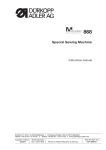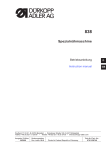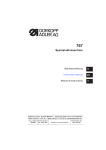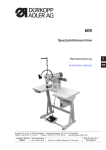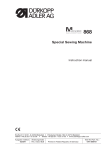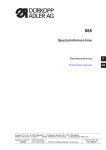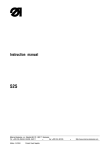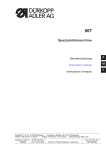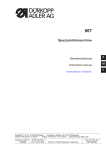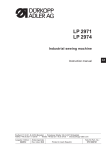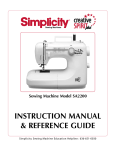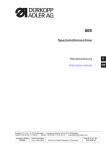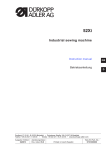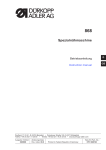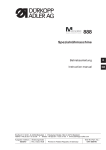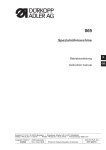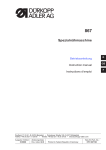Download Duerkopp Adler 887 Instruction manual
Transcript
887 Spezialnähmaschine Betriebsanleitung Instruction manual Postfach 17 03 51, D-33703 Bielefeld • Potsdamer Straße 190, D-33719 Bielefeld Telefon +49 (0) 521 / 9 25-00 • Telefax +49 (0) 521 / 9 25 24 35 • www.duerkopp-adler.com Ausgabe / Edition: 01/2013 Änderungsindex Rev. index: 01.0 Printed in Federal Republic of Germany Teile-Nr./Part.-No.: 0791 887740 Alle Rechte vorbehalten. Eigentum der Dürkopp Adler AG und urheberrechtlich geschützt. Jede, auch auszugsweise Wiederverwendung dieser Inhalte ist ohne vorheriges schriftliches Einverständnis der Dürkopp Adler AG verboten. All rights reserved. Property of Dürkopp Adler AG and copyrighted. Reproduction or publication of the content in any manner, even in extracts, without prior written permission of Dürkopp Adler AG, is prohibited. Copyright © Dürkopp Adler AG - 2008 Foreword This instruction manual is intended to help the user to become familiar with the machine and take advantage of its application possibilities in accordance with the recommendations. The instruction manual contains important information on how to operate the machine securely, properly and economically. Observation of the instructions eliminates danger, reduces costs for repair and down-times, and increases the reliability and life of the machine. The instruction manual is intended to complement existing national accident prevention and environment protection regulations. The instruction manual must always be available at the machine/sewing unit. The instruction manual must be read and applied by any person that is authorized to work on the machine/sewing unit. This means: – – – Operation, including equipping, troubleshooting during the work cycle, removing of fabric waste, Service (maintenance, inspection, repair) and/or Transport. The user also has to assure that only authorized personnel work on the machine. The user is obliged to check the machine at least once per shift for apparent damages and to immediatly report any changes (including the performance in service), which impair the safety. The user company must ensure that the machine is only operated in perfect working order. Never remove or disable any safety devices. If safety devices need to be removed for equipping, repairing or maintaining, the safety devices must be remounted directly after completion of the maintenance and repair work. Unauthorized modification of the machine rules out liability of the manufacturer for damage resulting from this. Observe all safety and danger recommendations on the machine/unit! The yellow-and-black striped surfaces designate permanend danger areas, eg danger of squashing, cutting, shearing or collision. Besides the recommendations in this instruction manual also observe the general safety and accident prevention regulations! General safety instructions The non-observance of the following safety instructions can cause bodily injuries or damages to the machine. 1. The machine must only be commissioned in full knowledge of the instruction book and operated by persons with appropriate training. 2. Before putting into service also read the safety rules and instructions of the motor supplier. 3. The machine must be used only for the purpose intended. Use of the machine without the safety devices is not permitted. Observe all the relevant safety regulations. 4. When gauge parts are exchanged (e.g. needle, presser foot, needle plate, feed dog and bobbin) when threading, when the workplace is left, and during service work, the machine must be disconnected from the mains by switching off the master switch or disconnecting the mains plug. 5. Daily servicing work must be carried out only by appropriately trained persons. 6. Repairs, conversion and special maintenance work must only be carried out by technicians or persons with appropriate training. 7. For service or repair work on pneumatic systems, disconnect the machine from the compressed air supply system (max. 7-10 bar). Before disconnecting, reduce the pressure of the maintenance unit. Exceptions to this are only adjustments and functions checks made by appropriately trained technicians. 8. Work on the electrical equipment must be carried out only by electricians or appropriately trained persons. 9. Work on parts and systems under electric current is not permitted, except as specified in regulations DIN VDE 0105. 10. Conversion or changes to the machine must be authorized by us and made only in adherence to all safety regulations. 11. For repairs, only replacement parts approved by us must be used. 12. Commissioning of the sewing head is prohibited until such time as the entire sewing unit is found to comply with EC directives. 13. The line cord should be equipped with a country-specific mains plug. This work must be carried out by appropriately trained technicians (see paragraph 8). It is absolutely necessary to respect the safety instructions marked by these signs. Danger of bodily injuries ! Please note also the general safety instructions. Contents Page: Preface and general safety instructions Part 1: Operating Instructions Class 887 - Original Instructions (Edition 06/2008) 1. Product description . . . . . . . . . . . . . . . . . . . . . . . . . . . . . . . . . . . . . . . . . . . . 5 2. Designated use . . . . . . . . . . . . . . . . . . . . . . . . . . . . . . . . . . . . . . . . . . . . . . . 5 3. 3.1 3.2 Subclasses and sewing equipment Subclasses . . . . . . . . . . . . . . . . . . . . . . . . . . . . . . . . . . . . . . . . . . . . . . . . . . Sewing equipment . . . . . . . . . . . . . . . . . . . . . . . . . . . . . . . . . . . . . . . . . . . . . . 6 6 4. Optional equipment. . . . . . . . . . . . . . . . . . . . . . . . . . . . . . . . . . . . . . . . . . . . . 7 5. Technical data . . . . . . . . . . . . . . . . . . . . . . . . . . . . . . . . . . . . . . . . . . . . . . . . 8 6. 6.1 6.2 6.3 6.4 6.4.1 6.4.2 6.5 6.6 6.7 6.8 6.9 6.10 6.11 6.12 6.13 6.13.1 6.13.2 Machine operation Threading the needle thread . . . . . . . . . . . . . . . . . . . . . . Winding the hook thread . . . . . . . . . . . . . . . . . . . . . . . . Inserting the bobbin and threading the hook thread . . . . . . . . Adjusting the thread tension . . . . . . . . . . . . . . . . . . . . . . Adjusting the hook thread tension . . . . . . . . . . . . . . . . . . . Adjusting the needle thread tension . . . . . . . . . . . . . . . . . . Switching the thread tensioner on/off . . . . . . . . . . . . . . . . . Adjusting the thread regulator . . . . . . . . . . . . . . . . . . . . . Needle change . . . . . . . . . . . . . . . . . . . . . . . . . . . . . . Lifting and folding the roller presser. . . . . . . . . . . . . . . . . . Sewing-foot pressure . . . . . . . . . . . . . . . . . . . . . . . . . . Reverse sewing (Backtacking) . . . . . . . . . . . . . . . . . . . . . Setting the stitch length . . . . . . . . . . . . . . . . . . . . . . . . . Starting up the manually controlled machine with a clutch motor Controlling the machine equipped with a positioning motor. . . . By a control pedal . . . . . . . . . . . . . . . . . . . . . . . . . . . . By a key panel . . . . . . . . . . . . . . . . . . . . . . . . . . . . . . . . . . . . . . . . . . . . . . . 9 9 10 11 11 12 13 14 15 16 17 18 19 19 20 20 21 7. 7.1 Positioning motor Efka DC1600/DA82GA General . . . . . . . . . . . . . . . . . . . . . . . . . . . . . . . . . . . . . . . . . . . . . . . . . . . . . 22 8. 8.1 Positioning motor (drive) Efka VD552/6F82FA General . . . . . . . . . . . . . . . . . . . . . . . . . . . . . . . . . . . . . . . . . . . . . . . . . . . . . 22 9. 9.1 Positioning drive Efka DC1550/DA321G General . . . . . . . . . . . . . . . . . . . . . . . . . . . . . . . . . . . . . . . . . . . . . . . . . . . . . 23 GB . . . . . . . . . . . . . . . . . . . . . . . . . . . . . . . . . . . . . . . . . . . . . . . . . . . . . . . . . . . . . . . . . . . . . . . . . . . . . . . . . . . . . . . . . . . . . . . . . . . . . . . . . . . . . . . . . . . . . . . . . . . . . . . . . . . . . . . . . . . . . . . . . . . . . . . . . . . . . . . . . . . . . . . . . . . . . . . . . . . . . . . . . . . . . . . . . . . . . . . . . . . . . . . . . . . . . . . . . . . . . . . . . . . . . . . . . . . . . . . . . . . . . . . . . . . . . . . . . . . . . . . . . . . . . . . . . . . . . . . . . . . . . . . . . Contents Page: 10. 10.1 10.2 Sewing with machine with positioning motor (drive) Machine automatic functions . . . . . . . . . . . . . . . . . . . . . . . . . . . . . . . . . . . . . . . . Example of machine operation at sewing . . . . . . . . . . . . . . . . . . . . . . . . . . . . . . . . 24 25 11. 11.1 11.2 Maintenance Cleaning and checking . . . . . . . . . . . . . . . . . . . . . . . . . . . . . . . . . . . . . . . . . . . Lubrication . . . . . . . . . . . . . . . . . . . . . . . . . . . . . . . . . . . . . . . . . . . . . . . . . . . 26 29 1. Product description Dürkopp Adler 887 is a special sewing machine for universal use. 2. • • It is a flatbed double-lockstitch machine. • Depending on subclass, the machine may be equipped with a large or oversized hook, with automatic functions such as thread trimming, automatic backtacking, automatic foot lifting. • • • • Equipped with a two-piece vertical hook. • The throat plate has replaceable inserts with the stitch hole dimension difference, which are optional in dependence on the needle number. • Automatic wick lubricating with an inspection glass on the arm for machine and hook lubrication. • Integrated winder. The machine has a double intermittent feeding. A lower wheel feeder and a driven roller presser feed in two steps, a needle feed feeds in the first step only. The first step represents 50% of the total stitch length. With a maximum of 12 mm clearance when sewing feet are lifted. The residual thread length after thread trimming is about 15 mm. A safety clutch prevents a changing of the hook setting or a hook damage in the case of a thread deflection into the shuttle track. GB Designated use The 887 is a sewing machine designated for shoe, leather, and upholstery sewing. The usual material is leather (natural or artificial). It is possible to use it for shoe fabrics too. The equipment for light, medium or heavy sewing is mounted on the machine as an option. This special sewing machine can also be used to produce so-called technical seams. In this case, however, the operator must assess the possible dangers which may arise (with which DÜRKOPP ADLER AG would be happy to assist), since such applications are on the one hand relatively unusual and, on the other, so varied that no single set of criteria can cover them all. The outcome of this assessment may require appropriate safety measures to be taken. Generally only dry material may be sewn with this machine. The material may be no thicker than 7 mm when compressed by the lowered sewing feet. The material may not contain any hard objects, since if it does the machine may not be operated without an eye-protection device. No such device is currently available. This special sewing machine may be set up and operated only in dry, well-maintained premises. If the sewing machine is used in premises which are not dry and well-maintained it may be necessary to take further precautions (which should be agreed in advance - see EN 60204-31:1999). As manufacturers of industrial sewing machines we proceed on the assumption that personnel who work on our products will have received training at least sufficient to acquaint them with all normal operations and with any hazards which these may involve. 5 3.1 Subclasses 0887 160020 X X X 0887 160040 X X X 0887 160122 X X X 0887 160142 X X X very big, two part big, two part Trimming and backtacking X X X X X X X X 70-80 70 80-60 60 4 3000 2500 medium 90-110 90 50-30 40 5 2500 2500 120-160 120 25-10 20 7 2000 1600 heavy 35 mm mm mm - - - - - - * When sewing very thick layers, it is necessary to reduce the sewing speed significantly. ** Equivalent acoustic pressure level of a separate machine in the workplace by 20 % use of the machine. Measured at the maximum stitch length and maximum sewing speed in compliance with DIN 45635-48-A-1-KL2. 6 Machine noise ** light mm Trimming distance from the needle 1/min Seam distance 1/min Wheel feed tooth pitch mm crosswise grooving - Standard * - Top roller diameter Sewing speed Polyester thread label number Needle number 0,01 mm Scope 0,01 mm Sewing category Maximum 887-E3 1 Maximum stitch length 0887 160020 0887 160040 0887 160122 0887 160142 Standard 887-E2 Scope 0887 160020 0887 160122 Standard 887-E1 Number of needles For classes and subclasses Sewing equipment Sewing equipment 3.2 Hook automatic foot lifting and pneumatic backtacking manual automatic foot lifting and electric backtacking Machine control up to 7 mm Stitch length up to 5 mm 1 needle, hook to the right of the needle Class and subclass Needle number with trimming, automatic backtacking Subclasses and sewing equipment without trimming, manual backtacking 3. dB (A) 4. Optional equipment Order number Optional equipment 0888 220334 Roller presser Æ 25 mm knurled 0888 220344 Roller presser Æ 25 mm smooth 0888 220354 Roller presser Æ 25 mm rubberized 0888 220364 Roller presser Æ 35 mm knurled (basic) 0888 220374 Roller presser Æ 35 mm smooth 0888 220384 Roller presser Æ 35 mm rubberized 0888 220394 Roller presser Æ 45 mm, width 3.8 mm 0888 220404 Roller presser Æ 45 mm, width 2.0 mm 9880 888100 Diode lamp MG55 400334 Stand set MG 55-3 for the machine driven with a V-belt (contains a frame, pedal, drawer and a table top 1060 x 500 mm) MG55 400324 Stand set MG 55-3 for the machine driven with a toothed belt (contains a frame, pedal, drawer and a table top 1060 x 500 mm) 0700 088802 Stand top plate for the V-belt 0700 088804 Stand top plate for the toothed belt N800 080030 Tiltable material guide N800 080004 Tiltable material guide with a roller 0887 320143 Wheel feeder rubberized N800 015412 Tiltable material guide with a roller on the slide plate GB 7 5. Technical data Stitch type double lockstitch 301 Needle system 134LR, 134 KKLR, 134, 134 D Foot lifting with a hand lever 6 mm Foot lifting with a knee lever or automatically 12 mm Thread length after trimming max. 15 mm Machine head clearance height 137 mm Machine head clearance width 280 mm Machine base plate plan dimensions 178 x 518 mm Table top plan dimensions 1060 x 500 mm Table top minimum height 740 mm Table top maximum height 900 mm Machine height max. 1630 mm Maximum input (short-time) 0,8 kW Weight of machine head 0887 160020, 0887 160040 Weight of machine head 0887 160122, 0887 160142 Weight of stand 30 kg Weight of motor FIR 19 kg Weight of motor EFKA DC 1600 18 kg Weight of motor EFKA DC 1550 10 kg 8 6. Machine operation 6.1 Threading the needle thread 1 Caution! Risk of injury! Turn off the main switch. The needle thread may only be threaded with the sewing machine switched off. – 6.2 Winding the hook thread – – – – – – GB Thread the single needle machine according to Fig. If the machine is equipped for heavy sewing, wind the thread around the pin (1). 2 1 3 4 Thread the thread according to the picture. Insert the thread under the knife (1) and tear off by pulling in the arrow direction (2). Fix the bobbin and press the lever (3) in the direction (4). Start the machine up. After the thread winding, slide the thread under the knife again (1) and tear it off. Insert another bobbin immediately and press the lever (3). 9 6.3 Inserting the bobbin and threading the hook thread 2 10 3 6 1 4 5 Caution! Risk of injury! Turn off the main switch. The hook-thread bobbin may only be changed with the machine switched off. – – – – 10 Tilt the shutter (1) up. Insert the bobbin (2) with the thread end (3) oriented according to the picture. Thread the thread through the slit (4) and space (5), hook upon the shutter (1) and fasten it under the spring (6). Trim the thread ends according to the picture. 6.4 Adjusting the thread tension 6.4.1 Adjusting the hook thread tension 3 1 Caution! Risk of injury! Turn off the main switch. The hook thread tension may only be adjusted with the machine switched off. – – Adjust the hook thread tension by the screw (1) with a screwdriver. The tension is increased by tightening the screw. Measure the thread tension with a dynamometer. Thread the thread according to the picture and pull in the arrow direction (3). This tension is adjusted in the factory in dependence on the selected sewing equipment according to the below table, and it is suitable for the usual sewing operations. For sewing thin soft materials, it is necessary to reduce the tension. If the seam is to be tightened strongly, it is necessary to increase the tension and reduce the sewing speed at the same time. Hook thread tension mean value Sewing category Needle used thread Nadelstärke Nm Tension in grams light 70-80 50 medium 90-110 65 heavy 120-160 90 11 GB 6.4.2 Adjusting the needle thread tension 1 2 3 4 Supplementary tensioner adjustment (1) – Adjust the supplementary tensioner (1) so that it has the lowest tension possible, but so high that, when taking out the sewn material after the preceding trimming (when the tensioners (2) and (3) are switched off), the thread is not pulled out of the tensioner (1). (Tensioner (1) is not switched off at the foot lifting). Tensioner (2) and (3) adjustment The machine can be equipped with a lever (4) for the tensioner (2) temporary switching off. In this case, two thread tension values can be pre-selected and a good stitch tightening can be achieved when sewing over a variable number of layers of the sewn material with one seam. – Switch the tensioner off (2) with the lever (4) and sew on a smaller number of layers. – Regulate the thread tension with the tensioner (3), till a good thread loop is achieved (see opposite figure). – Switch the tensioner on (2) by the lever (4) shifting out and sew on a greater number of layers. – Regulate the thread tension with a tensioner (2), till a good thread loop is achieved (see opposite figure). – If the machine is not equipped with the lever (4), regulate the tension by both tensioners (2) and (3) at the same time so that their nuts are screwed approximately in the same height. 12 Correct thread interlacing in the center of the material Needle-thread tension too low or hook-thread tension too high Needle-thread tension too high or hook-thread tension too low 6.5 Switching the thread tensioner on/off 1 GB 2 3 4 All machines – When pulling the hand lever (1) towards the operator, the tensioners (3) and (4) are switched off. – Tensioner (2) is never switched off. Manually controlled machines (without the thread trimming) – Tensioners (3) and (4) are mechanically switched off when the foot is lifted with a hand or knee lever. Machines with the thread trimming – Tensioners (3) and (4) are switched off with an electric magnet or pneumatic cylinder at the foot automatic lifting. If the automatic foot lifting at the machine stop is pre-selected, the tensioners are switched off, but temporarily only, so that the switching off electric magnet does not overheat. – Tensioners (3) and (4) are also switched off temporarily during the trimming cycle. – Tensioners (3) and (4) are not switched off at the foot lifting with the hand or knee lever. 13 6.6 Adjusting the thread regulator 2 1 1234 The thread regulator (2) controls the quantity of needle thread required for stitch formation. The thread regulator must be precisely adjusted for an optimum result. – Loosen the screw (1), shift the thread regulator (2), and tighten the screw (1). – For most of the sewing operations, the regulator optimal setting is with its right edge corresponding to the No. 2. – For a thin material layer and a very short stitch only, the setting corresponding to the No. 3 is suitable. 14 6.7 Needle change 1 2 MAX. 3° 3 4 5 Caution! Risk of injury! Turn off the main switch. The needle may only be changed with the sewing machine switched off. – – – GB Draw the lever (1) in your direction to loosen the screw fixing the needle. Remove the needle and insert a new one with the needle scarf (2) to the right according to the section (3) or (4). The needle may not be oriented according to the section (5). Turn the lever (1) back to tighten the needle fixing screw. Caution! A false orientation of the needle turning may cause the hook point destruction. When changing to another needle size, the distance between hook and needle must be readjusted (see service instructions). 15 6.8 Lifting and folding the roller presser 1 3 4 Lifting the roller presser with a hand lever – Lift the roller presser by the lever turning (1) in the arrow direction to the stop (the roller presser remains lifted, the lever (1) remains tilted). – Lower the roller presser by putting the lever (1) to the initial position, or by pressing the knee lever (3) and its subsequent release. – After the roller presser lifting with the hand lever, the machine may be started up (e. g. at the hook thread winding). Roller presser lifting with the knee lever – The roller presser is lifted by pressing the lever (3); the roller presser is lowered at the lever release. Caution! At the roller presser lifting higher than 6 mm over the throat plate the machine may not operate, otherwise the needle bar with the needle holder hits the roller presser, or the needle guides of the double needle machines. Roller presser lifting with a pedal - automatically – The roller presser lifting in the machines equipped with a positioning motor (drive) can be controlled by the pedal (4) treading in the position -1 (see par.6.13.1). The roller presser is lifted to the upper dead point by means of an integrated electric magnet or pneumatic cylinder. After the pedal is released, the roller presser is lowered. – It is possible to pre-select the automatic roller presser lifting at each machine stop without the necessity to tread the pedal in the position to the position -1. In this case, the roller presser is lowered at the pedal treading in the position +1. After the finishing of the seam, the roller presser remains lifted permanently. 16 Roller presser folding – – Lift the roller presser with the hand lever. Lift the roller presser by pressing in the signed direction. Caution! Risk of injury! Roller presser folding to be done at main switch off and standing motor. 6.9 Sewing-foot pressure GB + 1 – – – – Regulate the roller presser pressure with the setting wheel (1). To increase the roller presser pressure = turn the setting wheel (1) clockwise. To decrease the roller presser pressure = turn the setting wheel (1) anti-clockwise. The roller pressure is to be as small as possible, but strong enough that the roller presser is not lifted by the needle friction in the material during the upward movement and that the feeding is reliable. The maximum roller presser pressure is 100N in the machine equipped with electric magnets, and in the machine with the pneumatic cylinders 160N. 17 6.10 Reverse sewing (Backtacking) 1 2 3 Backtacking with a hand lever – Press the lever (1) downwards. As long as the reverse feed lever (1) is pressed down, the machine sews in reverse. Backtacking with a key – Press the key (2) or lever (3). The machine sews in reverse, as long as the key (2) or lever (3) is pressed down. Automatic backtacking (bartacking) In the machines equipped with the positioning motor it is possible to pre-select the backtacking by a pre-selected backstitches number both at the beginning and at the seam end. At the seam beginning (after the preceding thread trimming) after the pedal treading forwards the machine sews the pre-selected bartack entirely automatically. The same at the seam end after the pedal treading in the position –2 the machine sews the pre-selected end bartack and then trims the threads. 18 6.11 Setting the stitch length 3 2 – 1 Turn the button (1) so that the number (2) indicating the required stitch length in mm is opposite the mark (3). GB 6.12 Starting up the manually controlled machine with a clutch motor 2 1 3 – – – – Switch on the motor (1) with a switch (2) – the drive motor operates permanently. Tread the pedal (3). The motor friction clutch gets switched and the sewing machine starts running. Regulate the sewing speed by the pressure on the pedal (3). Dependent on this pressure, the clutch slip changes and subsequently the machine speed as well. Release the pedal (3). The sewing machine stops. 19 6.13 Controlling the machine equipped with a positioning motor 6.13.1 By a control pedal -2 -1 0 1 2 13 The pedal position is scanned by a sensor distinguishing 16 levels. The meaning is given in the table: Pedal position Pedal motion Meaning -2 Over heel fully backwards Command for thread trimming (seam finishing) -1 Over heel slightly backwards Command for foot lifting 0 Neutral position See notes 1 Slightly forwards Command for foot lowering 2 Further forwards Sewing at minimum speed (1. speed gear) 3 Further forwards Sewing - 2. speed gear : : : 13 Fully forwards Sewing at maximum speed (12. speed gear) Note: In addition to the neutral position, it is possible to pre-select the needle position (down/up) and the foot position (down/up) at the stopping in the seam (by the pedal positioning in the neutral position), the foot position (down/up) after the seam finishing (by the pedal treading fully backwards and positioning the pedal in the neutral position). 20 6.13.2 By a key panel 7 Key 8 10 9 11 1 2 3 4 Function 1 Manual bactacking When the key is pressed during the sewing, the sewn material is fed backwards. 2 Needle positioning to the upper or lower position By parameter F-140 (Efka DA82GA); F-242 (DA321) the following function keys can be defined: 1 = needle up (DA82GA); needle up/down (DA321) 2 = needle up/down (DA82GA); needle up (DA321) 3 = one stitch 4 = one stitch with the second/shorter stitch length (in machines with this equipment) 5 = needle up, if it is out of position 2 (factory setting is 1 = needle up) 3 Calling out/cancellation of the start or end bartack If the start and end bartack are switched on, the following bartack is switched off by pressing the key. If the start and end bartack are switched off, the following bartack is switched on by pressing the key. 4 Half length stitch By pressing the key 1 stitch of half length is sewn. LED 8 and 9 10 GB Function Warning of an empty bobbin in the machines with rest bobbin thread sensor (left/right bobbin). LED signals the network switching on Through the arresting of the pin 11 under the key 1 it is possible to transfer the key 1 function to key 7: - select the function (e. g. 1 = manual backtacking) - turn the pin 11 under the key 1 by 90° clockwise (the groove is vertical) The manual backtacking function can be called out by the keys 1 and 7 now. CAUTION! Before key (7) can be programmed with a new function, the former setting must be deactivated. 21 7. Positioning motor Efka DC1600/DA82GA 7.1 General For a detailed description of the control unit, please consult the enclosed current issue of the operating manual of the motor manufacturer (see also www.efka.net). 8. Positioning motor (drive) Efka VD552/6F82FA 8.1 General For a detailed description of the control unit, please consult the enclosed current issue of the operating manual of the motor manufacturer (see also www.efka.net). 22 9. Positioning drive Efka DC1550/DA321G 9.1 General For a detailed description of the control unit, please consult the enclosed current issue of the operating manual of the motor manufacturer (see also www.efka.net). GB 23 10. Sewing with machine with positioning motor (drive) 10.1 Machine automatic functions The machine has the below functions which are automatically performed during the seam sewing depending on: – Pre-selection – Pedal position (according to the machine operator´ s selection) – Working phase of seam sewing Automatic function Needle positioning Pre-selection • Needle down at machine stopping in seam • Needle up at machine stopping in seam Note: after the seam * finishing the machine stops always with the needle up. Bartacks • Standard • Decorative** Initial bartack • Single • Double • Standard bartack stitch number forwards • Decorative bartack stitch number forwards • Standard bartack stitch number backwards • Decorative bartack stitch number backwards End bartack • Single • Double • Standard bartack stitch number backwards • Decorative bartack stitch number backwards • Standard bartack stitch number forwards • Decorative bartack stitch number forwards Thread trimming • ON • OFF Automatic foot lifting • Foot lowered at stopping in seam • Foot lifted at stopping in seam • * The seam is finished after the pedal shifting to the position -2 (if the thread trimming is pre-selected, then after the trimming). ** The decorative bartack is characterized by the fact that the needle sews stitch in stitch in the previous seam at the bartacking. At the sewing direction change the machine stops for a moment. 24 10.2 Example of machine operation at sewing Pre-selection: Needle down at machine stopping in seam Standard bartacks Double initial bartack Double end bartack Thread trimming on Foot lowered at stopping in seam Foot lifted at seam finishing Operator´ s action Machine work Machine stopped. Needle in upper position. Foot lifted in accordance with pre-selection. Insertion of sewn material. Pedal treading to position +1. Foot lowering. Pedal release to position 0. Foot lifting. Material position correction. Pedal treading to position +1. Foot lowering. Pedal treading to position +3. Sewing of standard double bartack (at speed pre-selected by producer and subsequent sewing at speed corresponding with third speed level +3. Pedal release to position 0. Machine stopping with needle down. Pedal treading to position -1. Foot lifting. GB Turning of sewing material on needle. Pedal treading to position +5. Foot lowering and subsequent machine running to fifth speed grade of sewing. Pedal treading to position -2. Speed reduction. Sewing of standard double bartack. Thread trimming under throat plate and machine stopping with needle up. Foot lifting. Pedal release. (Foot remains lifted). Putting out of sewn material. 25 11. Maintenance 11.1 Cleaning and checking Caution! Risk of injury! Maintenance may be carried out only with the machine switched off and the motor stopped! Maintenance work must be carried out no less frequently than at the intervals given in the tables (see ”operating hours” column). Maintenance intervals may need to be shorter when processing heavy-shedding materials. 2 4 6 5 3 1 7 Maintenance work to be carried out Explanation Operating hours Machine head - Remove lint, pieces of thread and other debris (e.g. with an air blow gun) - Remove lint, pieces of thread and other debris (e.g. with an air blow gun) - Check the hook 26 Places in special need of cleaning: - area under the throat plate , feed dog (2), roller foot. - area around the hook (1) - bobbin housing (6) - thread trimmer - needle area CAUTION ! Hold the air blow gun in a way that the lint is not blown into the oil sump. Dismantle the throat plate, thread pulling knife (4), dismantle the hook plunger ring (5), remove the bobbin housing (6) from the hook. Clean the inner part of the hook, clean the bobbin housing - especially the glue remainder on the surface (7). Check the clearance of the bobbin housing (6) and the hook (1). 8 20 500 4 3 2 1 Maintenance work to be carried out Explanation Operating hours - Clean the oil sump. Cleaning the oil sump (1) for example with a special vacuum cleaner. 20 - Clean fan grille. Remove lint and pieces of thread from air-intake openings (2) and (3) (e.g. with an air blow gun). 20 - Check condition and tension of V-belt. Check the condition of the V-belt (4). (check the service instructions). 500 GB 27 6 4 8 2 10 1 2 3 Maintenance work to be carried out Explanation Operating hours Pneumatic system - Check water level in pressure regulator. The water level must not rise to the level of the filter cartridge (1). - After unscrewing the drain screw (3), the water under pressure will flow out of the water separator (2). 40 - Clean filter cartridge. Dirt and condensation are separated out by the filter cartridge (1). - Disconnect the machine from the compressed-air supply. - Unscrew the drain screw (3). There must be no pressure in the machine’s pneumatic system. - Unscrew water separator (2). - Unscrew filter cartridge (1). Wash the filter shell and cartridge with cleaning fluid (no solvent) and blast clean. - Re-assemble the maintenance unit. 500 - Check the system for leaks. 28 500 11.2 Lubrication 2 1 3 Caution: danger of injury Oil can cause skin eruptions. Avoid protracted contact with the skin. In the event of contact, thoroughly wash the affected area. CAUTION: The handling and disposal of mineral oils is subject to legal regulation. Deliver used oil to an authorised collection point. Protect your environment. Take care not to spill oil. To lubricate the special sewing machine use only DA-10 lubricating oil or an equivalent oil of the following specification: – Viscosity at 40° C: 10 mm²/s – Flashpoint: 150° C DA-10 is available from DÜRKOPP ADLER AG retail outlets under the following part numbers: 250-ml container: 9047 000011 1-litre container: 9047 000012 2-litre container: 9047 000013 5-litre container: 9047 000014 If the oil volume drops to the level (3), supply the oil through the hole (2) to the “MAX” level. Check the oil level every day! All points of the sewing machine head lubricated with oil are supplied from the central tank (1). Caution! Risk of failure! The oil may be supplied only into the central tank or in the hook path. The other points must not be lubricated separately, so that the oil does not penetrate to the spots, which must not be lubricated. 29 GB Notes: 30 Contents Page: Part 2: Installation Instructions Class 887 1. Scope of delivery. . . . . . . . . . . . . . . . . . . . . . . . . . . . . . . . . . . . . . . . . . . . . 3 2. General and transport packing . . . . . . . . . . . . . . . . . . . . . . . . . . . . . . . . . . . . 4 3. 3.1 3.2 3.2.1 3.2.2 3.3 Assembling the stand Assembling the stand components . . . . . . . . . . . . . . . . . . . . . . . . . . . . Assembling the table plate . . . . . . . . . . . . . . . . . . . . . . . . . . . . . . . . . Assembling the table plate in the machine with the motor on the stand table top Assembling the table plate with the motor on the machine head (direct drive) . . Setting the working height . . . . . . . . . . . . . . . . . . . . . . . . . . . . . . . . . 4. 4.1 4.2 4.3 4.4 4.5 4.6 4.7 Assembling the machine head Fitting the machine head . . . . . . . . . . . . Fitting and tensioning the V-belt . . . . . . . . Fitting the belt guards. . . . . . . . . . . . . . . Setting the pedal. . . . . . . . . . . . . . . . . . Installation of knee lever and oil pump pipe . Fitting the proximity switch. . . . . . . . . . . . Installation of connecting cable, control panel machine head . . . . . . . . . . . . . . . . . . . . . . . . . . . . . . . . . . . . . . . . . . . . . . . . . . . . . . . . . . . . . . . . . . . . . . . . . . . . . . . . . . . . . . . . . . . . . . . . . . . . . . . . . . . . . . . . . . . . . . . . . . . . . . . . . . . . . and sewing diode lamp on the . . . . . . . . . . . . . . . . . . . . . . . . . . . . . . . . . . . . . . . . . . . . . . . . . . . . . . 4 5 5 6 7 . . . . . . . . . . . . . . . . . . . . . . . . . . . . . . . . . . . . . . . . . . 8 9 10 11 12 13 . . . . . . . . . 14 . . . . . . . . . . . . 5. 5.1 5.1.1 5.2 5.3 5.3.1 5.3.2 5.3.3 Electrical connection Electric connection of machine to low voltage network . . Sewing lamp transformer connection to network voltage . Earthing . . . . . . . . . . . . . . . . . . . . . . . . . . . . . . Connection of machine head electric equipment to drive. Connecting the Efka VD552KV/6F82FA drive . . . . . . . Connecting the Efka DC1600/DA82GA drive . . . . . . . . Connecting the Efka DC1550/DA321G drive . . . . . . . . . . . . . . . . . . . . . . . . . . . . . . . . . . . . . . . . . . . . . . . . . . . . . . . . . . . . . . . . . . . . . . . . . . . . . . . . . . . . . . . . . . . . . . . . . . . . . . . . . . . . . . . . . . . . . . . . . . . . . . . 15 16 17 18 18 18 19 6. 6.1 6.1.1 6.1.2 6.1.3 6.2 6.2.1 6.2.2 6.2.4 6.2.5 6.3 Setting of positioning motor (drive) Setting of positioning motor (drive) parameters . . . . . . . . . . . Autoselect. . . . . . . . . . . . . . . . . . . . . . . . . . . . . . . . . . Setting of parameters . . . . . . . . . . . . . . . . . . . . . . . . . . Setting machine-specific parameters . . . . . . . . . . . . . . . . . Setting of machine positioning . . . . . . . . . . . . . . . . . . . . . Position definition . . . . . . . . . . . . . . . . . . . . . . . . . . . . . Setting the machine positioning for DC1600/DA82GA motor drive Setting of machine positioning with VD552/6F82FA drive . . . . . Checking of set positions . . . . . . . . . . . . . . . . . . . . . . . . Master reset . . . . . . . . . . . . . . . . . . . . . . . . . . . . . . . . . . . . . . . . . . . . . . . . . . . . . . . . . . . . . . . . . . . . . . . . . . . . . . . . . . . . . . . . . . . . . . . . . . . . . . . . . . . . . . . . . . . . . . . . . . . . . . . . . . . . . . . . . . . . . . . . . . . . . . . . . . . . . . . . . . . . . . . . . . . . . . . . . . . . . . . . . . . . . . . . 20 20 20 21 23 23 23 24 25 25 7. Lubrication . . . . . . . . . . . . . . . . . . . . . . . . . . . . . . . . . . . . . . . . . . . . . . . . 25 8. Sewing test . . . . . . . . . . . . . . . . . . . . . . . . . . . . . . . . . . . . . . . . . . . . . . . . 25 . . . . . . . . . . . . . . . . . . . . . . . . . . . . GB 2 1. Scope of delivery What items are supplied depends on your order. Prior to setting up, please check that all the required parts are present. This description refers to a special sewing machine, of which all individual components can completely be delivered by Dürkopp Adler AG. 3 8 1 4 2 GB 7 5 6 Machine with the motor (drive) on the table top Machine with the direct drive on the machine head Required components: Machine head (1) Machine head (1) Accessories (includes oil tank (2), yarn stand (3), tools and other items Accessories (includes oil tank (2), yarn stand (3), tools and other items Set of parts for motor (includes belt guard (4), drive belt pulley and other parts dependent on drive) Set of parts for motor (includes direct drive (5), belt guard (4) and other parts) Optional components: Stand (6) Stand (6) Drive (7) Control panel (8) Control panel (8) 3 2. General and transport packing Caution: The special sewing machine must be set up by trained specialist personnel. If the special sewing machine you have bought is already set up, the following transport packing must be removed: – Safety straps and battens on the machine head, table and stand. – Safety block and straps on the sewing drive 3. 3.1 Assembling the stand Assembling the stand components 3 1 2 – – 4 Mount the frame according to the picture. Mount the pedal (1) provisionally. Its position will be adjusted after the whole machine is complete. Adjust the screw (2) so that the stand is stable. 3.2 Assembly of stand table top 3.2.1 Assembly of stand table top in the machine with the motor on the stand table top 7 8 9 5 6 4 3 10 2 260 10 1 36 8 80 15 15 96 11 15 14 12 13 16 32 8 0 80 14 28 30 770 50 185 – – – – – – – – – – – – – – – – – 17 GB Turn the table top (1) upside down. Screw the drawer (2). Put the oil tank (3) on the recess in the table top and slide it in the arrow direction (4) till the relevant protrusions of the tank are seated on the recess contour. Screw the tank. Screw the drive (5). Screw the sewing lamp transformer (6) – if there is any. Screw the cable clip (7). Screw the electric cable channel (8). Screw the switch (9). Mount electric cables according to par. 5 of this instruction. Pre-bore the holes (10) for wood screws and screw the stand frame. Then turn the stand to normal position. Mount the yarn stand (11) with the bar orientation according to the picture. Insert the machine head support pin (12). Screw the rubber hinge bottoms (13). Insert inclined bases (14) in the sockets in the recess corners. Insert the rubber corners (15). Remove the blinds from the bushing (16). Dismantle the knee lever (17) and push it through the bushing (16) according to the picture. 5 3.2.2 Assembly of stand table top with the motor on the machine head (direct drive) 10 8 9 2 3 5 6 1 10 7 260 4 36 8 15 50 460 11 80 14 180 15 15 12 15 13 32 16 8 30 80 30 72 185 770 17 – – – – – – – – – – – – – – – – – 6 Turn the table top (1) upside down. Screw the electric cable channel (2). Screw the pedal position sensor (3). Screw the electric cable clip (4). Put the oil tank on (5) and slide it in the arrow direction (6) till the relevant protrusions of the tank are seated on the recess contour. Screw the tank. Screw the drawer (7). Pre-bore the holes for wood screws and screw the drive control box (8). Screw the sewing lamp transformer (9) – if there is any. Mount the electric cables according to chapter 5 of this instruction. Pre-bore the holes (10) for the wood screws and screw the stand frame. Then turn the stand to normal position. Mount the yarn stand (11) with bar orientation according to the picture. Insert the machine head support pin (12). Screw the rubber hinge bottoms (13). Insert the inclined bases (14) in the sockets of the recess corners. Insert the rubber corners (15). Remove the blind from the bushing (16). Dismantle the knee lever (17) and slide it through the bushing (16) according to the picture. 3.3 Setting the working height 1 – – – – The stand height is adjustable between 750 and 900 mm. Loosen the screws (1). Set the required table top height and make sure that it is identical on both sides. To do that, use the scale on the stand feet. Set the stand height so that it corresponds with the operator’s body proportions. Tighten the screws (1). GB Caution! Risk of injury! Failure to adjust the stand height to the operator’s body proportions can cause damage to the operator’s locomotion system. 7 4. 4.1 Assembling the machine head Fitting the machine head 1 2 – – 8 If the sewing machine is equipped with a motor on the table top, insert the machine head (1) vertically in the recess in the table top. If the sewing machine is equipped with a motor (drive) on the machine head, tilt the machine head (2) and insert it in the table top recess. 4.2 Fitting and tensioning the V-belt This paragraph applies only to the machines with the motor on the table top. 20 mm F= 10 N 2 4 3 3 1 6 5 GB – – – – Mount the V-belt pulley (1) and the V-belt (2). Both items are included in the set of parts. Loosen the screws (3) and stretch the belt. The connecting rod (4) should be vertical approximately. The surface (5) horizontal approximately. Check the belt tension by force F = 10 N (~ 1 kg). The belt is expected to bend by 20 mm approximately. Adjust the stop (6) position protecting the belt against falling out at tilting the machine. 9 4.3 Fitting the belt guards 1 1 4 2 3 – – – – 10 Disassembly the hand wheel (1). In the machines with the motor on the table top mount the guard (2) on the machine head (the guard is included in the set of parts for motor) and mount the guard (3) on the motor (the guard is included in the motor package). In the machines with the motor on the machine head mount the guard (4) (is included in the set of parts for motor). Mount the hand wheel (1). Doing this, observe the correct angle position: if the needle is in the upper dead point, there should be the 0° value on the hand wheel scale. 4.4 Setting the pedal 3 2 90 ° 2 1 – – Adjust the side position of the pedal (1) so that its center lies on the needle axis. Adjust the draw rod (2) so that the foot axis is perpendicular to the pedal surface. Caution! Risk of injury! Failure to keep the determined pedal position can cause damage to the operator’s locomotion system. 11 GB 4.5 Installation of knee lever and oil pump pipe 1 4 6 5 3 7 9 10 8 10°± 5° – – – – – – 12 Tilt the machine head (1). Lift the foot with the hand lever. Slide the shaft (3) in the lever (4). Screw the screw (5) with the washer (6). Attach the pipe (7) with the clips (8) and install the suction basket (9). Tilt the machine head and adjust the knee lever (10) according to the picture. 4.6 Fitting the proximity switch 2 – – – – – 1 4 3 5 6 The proximity switch (1) is mounted to certain positioning motors (drives) only. In that case it is part of the drive supply. Slide the proximity switch (1) in the arrow (2) direction on the hand wheel shaft so that the carrier pin (3) fits in the proximity switch groove. Attach the proximity switch with two screws (4). Remove the back cover and pull the proximity switch cable (5) through according to the picture. Attach the cable with a clip (6). 13 GB 4.7 Installation of connecting cable, control panel and sewing diode lamp on the machine head 1 4 2 – – – – – – 14 3 6 5 7 8 The connecting cable (1) is supplied with every machine with the positioning motor (drive). The control panel (2) is an optional item. If it is ordered, however, a bracket (3) is always supplied together with it. The sewing diode lamp (5) is an optional item. Two types of brackets are supplied together with it to enable the installation of the lighting body in two positions. Position (5) is the basic one. Position (7) will be used if there is asewn material guide on the machine. Dismantle the upper cover and back cover of the machine head. Install the connecting cable with the connector (1) according to the picture. Install the control panel (2) with the bracket (3) and install the cable (4) according to the picture. Mount the sewing lamp (5) and install the cable (6) according to the picture. 5. Electrical connection The machine drive is supplied from the low voltage network. Caution! All work on the electrical equipment of this special sewing machine may only be carried out by qualified electricians or other appropriately trained persons. The mains plug must be removed. 5.1 Electric connection of machine to low voltage network According to the selected type the machine drive has a one-phase or three-phase supply. If the drive has the three-phase supply, it has an asynchronous motor. In that case it is necessary to adjust the connection of the coils in the motor terminal board (star or triangle) to the voltage of the local electric network. Caution! The mains voltage must agree with the rated voltage specified on the model-identification plate. GB The low voltage circuit includes the following items: – Supply plug – Main switch (with the drive on the machine head the main switch is incorporated in the drive) – Drive – Sewing lamp transformer (option) – Cables Part of these items is included in the drive package. The other part is included in the package of the set of parts for motor obligatorily supplied with the machine head. The division of the items can be seen in the catalog of spare parts. The low voltage circuit connection will be made according to the wiring schedule, which is included in the package of the set of parts for motor. Caution! Risk of electric current injury! The drives may be operated only with a safety conductor connected to the functional protective system in accordance with the regulations and rules to avoid personal injuries by electric current or fire. The drive operation will become dangerous if the safety conductor inside or outside the drive is disrupted. The protection must not be disrupted with e. g. an extension cord without the protective conductor. 15 5.1.1 Sewing lamp transformer connection to network voltage Caution! Risk of electric current injury! The sewing lamp transformer is not switched off by the main switch (EN 60 204-31)! At the sewing lamp installation and repair inside the transformer box, e.g. at a fuse replacement, the network plug must be disconnected from the network unconditionally. A. The machine is equipped with the following drives: FIR 1147 - F554.3 FIR 1148 - F752.3 Efka VD552KV/6F82FA Efka DC1600/DA82GA – Pull the network plug from the electric socket. – Conduct the transformer cable to the main switch. – Connect the transformer cable according to the wiring schedule, which is included in the delivery of the set of parts for motor supplied with the machine head. – Stick a self-sticking label with safety instructions on the front side of the main switch. B. The machine is equipped with the Efka DC1550/DA321G drive 2 6 5 – – – – – – – – – – – 16 1 6 5 4 3 Pull the network plug out of the socket. Screw out 4 screws on the front panel of the control box. Dismantle the front panel. Pull the transformer cable through the channel (1) in the control box. Remove the black rubber bushing (2). Pierce the bushing with a screwdriver. Pull the sewing lamp transformer cable through the arisen hole. Insert the rubber bushing back again. Press the clip openers (3) and (4) with a small screwdriver slightly until the clips (5) and (6) open. Connect the blue conductor to the terminal (6) and the brown conductor to the terminal (5). Screw the front panel back again. 5.2 Earthing 1 2 The earthing cable (1) is included in the accessory package of the machine head. – Connect the earthing cable (1) to the plug (2) (already screwed on the head hinge) and pull its opposite end under the table top. – Screw the opposite end of the grounding conductor to the relevant grounding point of the drive ( ). – Attach the cable with a clip on the bottom side of the table top. Caution! Make sure that the earthing cable (1) does not touch the driving V-belt (if there is any). GB Note: You do not need to care for the earthing with machines having the sewing motor fit onto the machine head, since it is already established through the fitted motor. 17 5.3 Connection of machine head electric equipment to drive The electric equipment on the machine head is described in chapter 4.6 and 4.7. Its connection to the drive is different depending on the selected drive type: 5.3.1 Connection of head to Efka VD552KV/6F82FA drive 4 3 2 1 The front panel of the drive box is shown in the picture. – Connect the connecting cable to the connector (1). – Connect the control panel (if there is any) to the connector (2). – Connect the synchronizer to the connector (3). Note: The pedal position sensor attached to the drive box is connected to the connector (4). 5.3.2 Connection of head to Efka DC1600/DA82GA drive 5 3 2 4 1 The front panel of the drive box is shown in the picture. 18 – – – Connect the connecting cable to the connector (1). Connect the control panel to the connector (2). Connect the synchronizer to the connector (3). Note: The pedal position sensor attached to the drive box is connected to the connector (4). The motor cable of this drive is connected to the connector (5). 5.3.3 Connection of the head to Efka DC1550/DA321G drive The direct drive Efka DC1550/DA321G with the motor on the machine head is different from the above drives by the drive attachment on the machine head directly. The synchronizer is integrated in the drive body and not located on the hand wheel (this applies, however, only for the motor : head gear rate 1:1). B 4 1 M B 2 B 8 0 M E B ... B 1 8 B 7 7 6 L S M ... V 8 . . A GB 7 41 2 – – – – – 9 3 5 Connect Connect Connect Connect Connect the the the the the 6 8 machine head connecting cable to the connector (1). control panel to the connector (2). synchronizer connector (3) to the connector (4). connector (5) of the motor (6) to the connector (7). pedal position sensor (8) to the connector (9). 19 6. Setting of positioning motor (drive) The function of the positioning motor (drive) is defined by its program, drive parameter setting, and the machine stopping positions. If the machine is supplied in the disassembled condition, the drive setting must be carried out by the purchaser. If the sewing machine is supplied in assembled condition, the drive is already set by the sewing machine manufacturer. 6.1 Setting of positioning motor (drive) parameters The setting of the drive parameters is carried out in two steps. In the first step, the parameters for the family of sewing machine class groups are set by the function “autoselect“. In the second step, some of the set parameters are changed to match the particular class. 6.1.1 Autoselect The drive control system is equipped with the “autoselect“ device, which is able to identify what sort of the sewing machine was connected to the drive (with a connection cable). At the drive switching on, the value of the resistance of the resistor located inside the sewing machine head for this purpose is measured automatically. As a result of this, the required parameter values are set automatically. If the control system is not able to identify the valid resistance, the drive control will run with so-called safety operation functions only to avoid the sewing machine damage. 6.1.2 Setting of parameters Caution! Change of the parameter value must be performed with consideration and in a responsible way. A false setting of the control may cause the machine damage! Warning! By the so-called master-reset (see chapter 6.3) it is possible to reset all parameter values back to the preset values again. Parameter selection and value change: – By the keys “+” and “-” the following or previous parameter is selected. – By the keys "+" and “-” it is possible to enter the parameter number directly. – Press the key “E”. The value of the selected parameter is displayed. – By the keys “+” and “-” the parameter value is changed. – 20 Press the key “E”. The value of the following parameter is displayed, or press the key “P” - the same parameter is displayed. 6.1.3 Setting machine-specific parameters 6.1.3.1 DC1600/DA82GA drive The value of the following parameters must be Parameter Orig. value New value 000 2 1* Stitch number of initial bartack forwards Parameter description 001 2 2* Stitch number of initial bartack backwards 002 2 2* Stitch number of end bartack backwards 003 5 3* Stitch number of end bartack forwards 111 - - 116 150 180* 140 1 2* 171-1E 160 164 171-1A 210 214 171-2E 440 440 171-2A 510 510 182 OFF ON 45° on hand wheel 190 450 190 Angular length of trimming switching on 192 210 190 196 0 2* 203 200 350 282 0 1* Max. sewing speed Speed of thread trimming Needle up/down 225° on hand wheel 65° on hand wheel Angular lag of tensioner magnet switching on Foot connection with tensioner switching off after trimming GB Time of foot magnet full current Machine operation blocking at opened contact * After the master-reset those parameter values must be set again. 6.1.3.2 VD552KV/6F82FA drive Parameter Original value New value Parameter description 000 2 1* Initial bartack stitch number forwards 001 2 2* Initial bartack stitch number backwards 002 2 2* End bartack stitch number backwards 003 5 3* End bartack stitch number forwards 111 - - 116 150 180* Trimming speed 140 1 2* Needle up/down 190 120 43 Angular length of trimming switching on 192 0 43 Angular lag of tensioner magnet switching on 196 0 2* Foot connection with tensioner switching off after trimming 203 200 350 282 0 1* Max. sewing speed Foot magnet full current time Operation blocking at opened contact * After the master-reset those parameter values must be set again. 21 6.1.3.3 DC1550/DA321G drive Parameter change for machines with gear rate of 28/28 teeth Parameter Original value New value 290* 0 3 Class of the machine Parameter description 111 - - Max. sewing speed 170 - - Reference position Parameter change for machines with gear rate 18/28 teeth Parameter Original value New value Parameter description 290* 0 4 Class of the machine 111 - - Max. sewing speed 170 - - Reference position * The parameter must be entered first. Attention: To set up parameters higher than 200, it is necessary to enter the control in the programmer’s level (via 3312 code). This allows also entering parameters lower than 200. 22 6.2 Setting of machine positioning 6.2.1 Position definition Position 1 The needle is down at the stopping in the seam. The angle 225° is on the hand wheel scale. Position 2 The needle is up after trimming. The angle 55° is on the hand wheel scale using the VD552KV drive, and 45° using the DC1600 and DC1550 motor drives. The 1A and 2A positions are important only for the internal functions of the DA82GA and DA321G controls. 6.2.2 Setting the machine positioning for DC1600/DA82GA motor drive and DC1550/DA321G For the needle and other elements positioning the incremental sensor located on the hand wheel is applied which gives 512 impulses (increments) and one additional impulse per rotation. In general, the particular position is defined by the number of increments between this position and the reference position. The increment number is set by the corresponding parameter value (it is not, however, identical with the parameter value). The position parameter values have already been set - see chapter 6.1.3.1. The reference position still remains to be set. The reference position is defined by the angle 105° on the hand wheel scale. After dismantling, mounting, or replacement of the synchronizer a new reference position must be set. See the “Efka DA82GA” or “Efka DA321G” operating manual. 23 GB 6.2.4 Setting of machine positioning with VD552/6F82FA drive The synchronizer contains one internal disc with increments (generator) for the speed regulation, one central adjustable diaphragm (1) to set the 1st needle position, and one marginal adjustable diaphragm (2) to set the 2nd needle position. Caution! At the position setting it is necessary to proceed with extreme caution! Danger of injury! At handling be sure that the diaphragms and generator disc are not damaged. 1 2 Caution! At the setting of the positioning diaphragms the network switch must be switched off unconditionally! – – – – – – – – – – – – – – 24 The direction of the drive rotation is already set correctly. After loosening the screw remove the speed sensor cover. By the key S5 (on the control box) select the needle lower position (LED 7 illuminates). Tread the pedal forwards shortly. Check the 1st position of the needle. If the needle is not in the 1st position, the central diaphragm for the 1st position (with the main switch switched off) must be turned in the required direction. Repeat the procedure until the 1st position is set correctly. Switch on the network switch. By the key S5 (on the control box) select the needle upper position (LED 8 illuminates). Tread the pedal forwards shortly. Check the 2nd position of the needle. If the needle is not in the 2nd position, the marginal diaphragm for the 2nd position (with the main switch switched off) must be turned in the required direction. Repeat the procedure until the 2nd position is set correctly. Put the speed sensor cover back again and screw. 6.2.5 Checking of set positions 1st position – Switch on the network switch. – Tread the pedal forwards shortly and release. The machine is stopped in the 1 st position. (see chapter 6.2.1). – Check the angle on the hand wheel scale (225° ± 5°). 2nd position – Tread the pedal forwards shortly at first and then entirely backwards with the heel until the machine stops. The machine stops in the 2 nd position. (see chapter 6.2.1). – Check the angle on the hand wheel scale (55° ± 5° or 35° ± 5°). 6.3 Master reset By means of the so-called master-reset all changed values are set back to the preset ones again. 7. Lubrication GB Before start, the machine must be lubricated properly with oil according to chapter 11.2 in the first part (operating instructions). 8. Sewing test This test can be carried out only after the machine is set completely. – Thread in the bobbin-winder thread (see operating instructions). – Turn on the main switch. – Lock the sewing foot in the lifted position (see operating instructions). – Fill the bobbin at low speed. – Turn off the main switch. – Thread in needle thread and bobbin thread (see operating instructions). – Select the material to be sewn. – Carry out the sewing test first at low speed and then gradually increase the speed. – Check whether the seams are of the desired quality. – If the quality requirements are not met change the thread tensions (see operating instructions). 25 Änderung der technischen Dokumentation Modification of the technical documentation Modification de la documentation tecnique Modificación de la documentación técnica Modificazione della documentazione tecnica Die vorliegende Anleitung hat sich nach Drucklegung geändert. Bitte tauschen Sie die beiliegenden Seiten in Ihrer Landessprache aus. The present instructions have changed since their last print out. Please insert the present new pages for replacing the old onces. Les présentes instructions ont subi un changement depuis leur dernière impression. Veuillez insérer les nouvelles pages pour remplacer les vieilles. Las presentes instrucciones han subido una modificación desde su última impresión. Por consiguiente hay que insertar las nuevas páginas para reemplazar las viejas. Las presentes instrucciones han subido una modificación desde su última impresión. Por consiguiente hay que insertar las nuevas páginas para reemplazar las viejas. Le seguenti istruzioni hanno subito un modifica dopo la loro stampa. Per favore inserite le nuove pagine sostituendo le vecchie. 887 Additional nstructions Machines with ntegrated otor About this manual 1 About this manual These additional instructions are supplementary to the manual of class 887 machines. They describe operation and functioning measures of machines with integrated motor that differ from machines without integrated motor. The additional instructions do not constitute a self-contained document, but are only valid in combination with the respective instruction manual. Make sure to read the instruction manual before setting up and operating the machine. By all means, pay heed to the general safety instructions of the instruction manual. Ignoring them can result in serious bodily injury and/or property damages. 2 Identification marks of machines with integrated motor Machines of subclasses ending with -M, have the motor integrated in the machine post. ECO-machines have the motor and the control unit integrated in the machine post. CLASSIC-machines have the motor integrated in the machine post and the control unit underneath the table top. Additional instructions: Machines with integrated motor - version 00.0 - dated 10/2012 1 ECO-machines 3 ECO-machines 3.1 Operation Fig. 1: Switching ECO-machines on and off 1 2 (1) - LEDs indicating the status (2) - Main switch for the power supply ECO-machines with integrated motor are switched on and off via the main switch (5) on the machine post. Switching the machine on 1. Press the main switch (2). ª Of the two LED lights (1) indicating the status, the top one will be lit. Switching the machine off 1. Press the main switch (2). ª Of the two LED lights (1) indicating the status, the top one will go out again. The bottom LED (1) serves as feedback when copying software updates. The copying of software and the programming of the functions is described in the DAC ECO instruction manual. The following settings for the sewing are effectuated on the operating panel on the machine post. Additional instructions: Machines with integrated motor - version 00.0 - dated 10/2012 2 ECO-machines Fig. 2: Operator settings with ECO-machines 1 (1) - Potentiometer P1 to decrease the speed 2 (2) - Button S1 for the needle's stopping position 3 (3) - Button S2 for the softstart Setting the maximum speed 1. Turn the potentiometer P1 (1). • To decrease the speed: Turn counter-clockwise. • To increase the speed: Turn clockwise The initial value is the maximum speed defined for this machine class. It cannot be increased, only decreased. ª This setting will be memorized and will also be valid after restarting the machine. Switching the needle's lifted position at sewing stop on / off 1. Press button S1 (2). ªThe LED above button S1 is lit: At sewing stop the needle will be lifted to top position. 2. Press button S1 (2) again. ªThe LED above button S1 goes out: The needle's lifted position at sewing stop is switched off. ª The respective setting will be memorized and will also be valid after restarting the machine. Switching the softstart on and off 1. Press button S2 (3). ªThe LED above the button S2 is lit: Sewing start with softstart. 2. Press button S2 (3) again. ªThe LED above the button S2 goes out. Sewing start without softstart. ª The respective setting will be memorized and will also be valid after restarting the machine. Additional instructions: Machines with integrated motor - version 00.0 - dated 10/2012 3 CLASSIC-machines 4 CLASSIC-machines 4.1 Operation Fig. 3: Switching CLASSIC-machines on and off Operating panel on the machine post Control beneath the table top 2 1 3 4 (1) - LEDs indicating the status (2) - Button for the sewing light (3) - Main switch for power supply (4) - Control light CLASSIC-machines are switched on and off at the control underneath the table top ( instruction manual). The two LEDs (1) on the machine post indicate the status of the power supply. • • Main switch (3) for the power supply is pressed: ªBoth status indicating LEDs (1) are lit: The machine is ready for sewing and the sewing light is energized. Switch for the sewing light (2) is pressed: ªOnly the top one of the two status-indicating LEDs (1) is lit: The sewing light energized, but the machine is not ready for sewing. Additional instructions: Machines with integrated motor - version 00.0 - dated 10/2012 4 CLASSIC-machines Fig. 4: Switching the sewing light on and setting the light intensity 1 (1) - Potentiometer P1 for an infinitely variable setting of intensity 2 (2) - Button S1 for the single-diode sewing light 3 (3) - Button S2 for the integrated sewing light Switching the sewing lights on and off 1. Press the button for the requested sewing light (S1 or S2). ªThe lamp lights up. 2. Press button (S1 or S2) again. ªThe lamp goes out. Setting the light intensity 1. Keep the button for the requested sewing light (s1 or S2) pressed, until the lamp briefly flickers. 2. Release the button. 3. Set the desired light intensity on the potentiometer (1): • Brighter: Turn clockwise • Less bright: Turn counter-clockwise 4. Press the same button again. ªThe lamp briefly lights up with the highest intensity. Then it goes out and lights up again with the intensity set with the potentiometer (1). ª This setting will be memorized and will also be valid after restarting the machine. Additional instructions: Machines with integrated motor - version 00.0 - dated 10/2012 5 CLASSIC-machines . Sewing light connection DANGER Risk of death due to electric shock The sewing light control is directly connected to the mains supply and is live even when the main switch is switched off. Therefore it is essential to pull out the mains plug, before you connect the sewing light. Make sure that the mains plug cannot be plugged in again by mistake. The PCB plug connector for the for the sewing light cable is situated on an extra PCB on the left side behind the valve cap. Fig. 5: Connecting the sewing light cable 1 2 3 (1) - Sewing light cable (2) - Plug connection for the cable of the integrated sewing light (3) - Plug connection for the cable of the single-diode light Connecting the sewing light cable: • Cable of the integrated sewing light: Plug connector on the top (2) • Cable of the single-diode sewing light: Plug connector in the center (3) Use the adapter 9870 867022. Additional instructions: Machines with integrated motor - version 00.0 - dated 10/2012 6 Subject to design changes - Printed in Germany - © Dürkopp Adler AG - Additional Instructions - 0791 867691 - 00.0 - DÜRKOPP ADLER AG Potsdamer Str. 190 33719 Bielefeld Germany Phone +49 (0) 521 925 00 E-Mail: [email protected] www.duerkopp-adler.com




































































